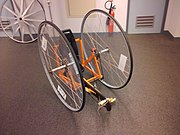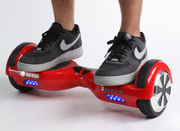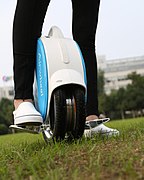
A dicycle (/ˈdaɪsɪkəl/) (also known as a diwheel) is a vehicle with two parallel wheels, side by side, unlike single-track vehicles such as motorcycles and bicycles, which have two wheels inline. Originally used to refer to devices with large wheels and pedals, the term is now used in relation to powered self-balancing scooters with smaller wheels and no pedals such as the Segway PT and the self-balancing hoverboard.
Etymology
In more recent usage, "dicycle" has been used for both pedaled and motorised vehicles with wheels of varying sizes, as long as they share a common axis, though not necessarily a common axle. In 2017, the Merriam-Webster's dictionary, limited usage to 'velocipedes with two parallel wheels,' and the Oxford English Dictionary limited it to 'pedal-powered vehicles with large wheels placed parallel to each other'.
Examples
Segway PT
The Segway PT is a two-wheeled self-balancing personal transporter which uses computers, sensors, and electric motors to keep the device upright. The rider commands the PT to go forward or backward by shifting their weight forward or backward on the platform. The maximum speed of the Segway PT is 12.5 miles per hour (20.1 km/h) with a range of 24 mi (39 km) on a fully charged lithium-ion battery, depending on terrain, riding style, and the condition of the batteries. Invented by Dean Kamen, it is produced by Segway Inc.
Self-balancing scooter
The self-balancing scooter is a category of personal transporter which includes all self-balancing powered portable devices with two parallel wheels that includes the Segway PT, the Segway miniPRO and the self-balancing hoverboard.
Diwheel design

The diwheel design has the two large outer wheels completely encompassing an inner frame. The inner frame is free to rotate within the wheels, and is typically supported by a common axle or idlers which roll on the wheels (see figure). Diwheels, like their more popular cousins the monowheel, have been around for almost one and a half centuries. All of these platforms suffer from two common issues affecting driver comfort; slosh and tumbling (also known as gerbilling). Sloshing is when the inner frame oscillates, and it occurs in all monowheels and diwheels where the centre of gravity of the inner frame is offset from the centre line of the wheels. It is very prevalent as these platforms typically have low damping between the wheel and the frame, to minimise power consumption during locomotion. In addition, during severe braking or acceleration the inner frame will tumble relative to the earth centred frame, which affects the ability of the driver to control the platform. Both the sloshing and tumbling issue can be controlled through feedback control, and has been demonstrated successfully. The equations of motion for the diwheel have been published.
Gallery
-
 Otto dicycle (1870s)
Otto dicycle (1870s)
-
 Dicycle at Delft University of Technology (photo 2011)
Dicycle at Delft University of Technology (photo 2011)
-
 A Self-balancing scooter
A Self-balancing scooter
-
 Airwheel Q5
Airwheel Q5
See also
- Cart – Wheeled vehicle for animal drawn transport
- Uno (dicycle) – Self-balancing electric motorcycle
References
- "DICYCLE | Meaning & Definition for UK English | Lexico.com". Lexico Dictionaries | English. Archived from the original on December 16, 2019.
- "Dicycles: The Scooter Gets a Hip Upgrade". Mashable. 1 May 2013.
- "Crazy Marshall Dicycle is an Electric Motorcycle and Mobile Disco in One". Inhabit. Archived from the original on 2017-05-09. Retrieved 2017-07-03.
- "Jack Mbatu on the dicycle". Eaken.
The dicycles cleared a grove of acacia trees, dodged termite mounds, and darted into a brushy thicket. They were not fast, but could cross rough and complicated landscape with ease
- "Dicycle". Merriam-Webster. Retrieved 2 July 2017.
A velocipede having the two wheels parallel instead of in the same line
- "Dicycle". Oxford English Dictionary. Retrieved 2 July 2017.
A pedal-powered vehicle with two large wheels placed parallel to one another, instead of being in line as in a bicycle; especially a vehicle of the design devised by E. C. F. Otto
- "i2 SE Personal Transporter". Archived from the original on May 27, 2016. Retrieved May 24, 2016.
- ^ US patent 6,752,231, personal transportation system (2002)
- "EDWARD - Electric Diwheel With Active Rotation Damping". University of Adelaid School of Mechanical Engineering. Archived from the original on 2013-05-19. Retrieved 2015-02-05.
- B. Cazzolato; J. Harvey; C. Dyer; K. Fulton; E. Schumann; C. Zhu; Z. Prime (2009). "Control of an electric diwheel" (PDF).
- "Dicycles and Diwheels - The Otto Dicycle". Museum of Retro Tech. Douglas Self. January 2002. Retrieved 24 February 2022.
Left: The Otto Dicycle: 1870s. Designed by a Mr Otto and manufactured in the 1870s by the BSA company of Britain. Note the little wheel on a stalk at the rear to stop you falling over backwards. Presumably falling forwards was your own responsibility.
External links
- US Patent Class 180/240 Archived 2021-02-24 at the Wayback Machine (lists all the vehicles coming under powered dicycles).
- Dicycles and Diwheels throughout history
- Dicyclet - pedal driven Dicycle by Dutch artist Fred Abels
- EDWARD, an electric dicycle by University of Adelaide students
- Di-Cycle: A Bike That Travels Over Land and Water